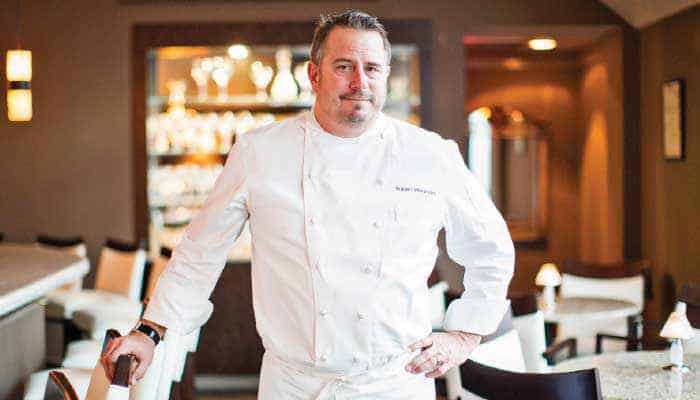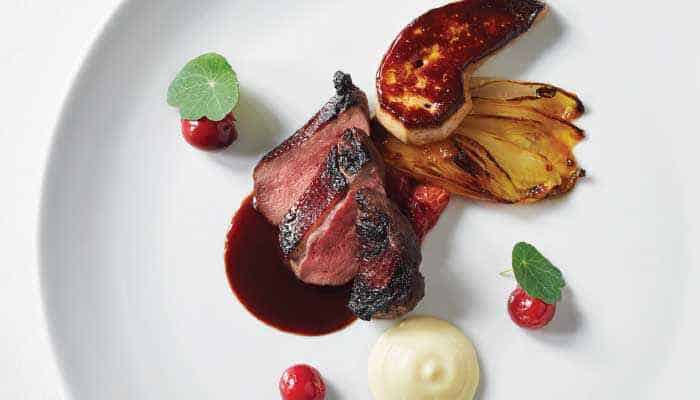If you haven’t been to Washington, D.C. since your high school field trip, there have been some changes. There are new things to see as well as classics not to be missed. Neighborhoods are gentrifying and a buzzy development called the Wharf is a new center of dining and entertainment. It already houses Del Mar, the Spanish restaurant from one of the city’s brightest culinary stars Fabio Trabocchi. Government is no longer the only business in town. Other industries, most notably tech, have brought in young professionals with money to spend and a desire to live in the city. The population has grown by over 100,000 in the last couple of years. Some 22 million visitors a year converge on the nation’s capital, one and a half million alone to see the cherry blossoms. Here are some highlights.

Smithsonian National Museum of African American History and Culture
This stunning museum, opened in September 2016, is reason enough to make the trip. The only museum dedicated to African American life journeys from the dark days of slavery to the more hopeful Civil Rights Movement up through the election of Barack Obama. Over 3,500 artifacts cover contributions in all walks of life; such as music, athletics, and politics. But what did the slaves eat? How did their foods become part of everyday life for slave and master alike? The Sweet Home Café poses edible answers.
It’s no surprise to find fried chicken and collards but who would have expected oyster pan roast from the North or Son of a Gun Stew from the West? “My biggest goal is to spotlight the incredible contributions African Americans made to American culture through the foods we eat,” says Albert Lukas, Supervising Chef, Mid-Atlantic region, Restaurant Associates. Lukas spent over two years researching the menu and is co-author of the “Sweet Home Café” cookbook. The café has proven emotionally moving. A striking photographic mural of a lunch counter sit-in dominates one wall. A young museum goer gasped when she recognized one of the protesters as her grandfather and burst into tears.
The National Air and Space Museum
Air and Space has always been one of my favorites. Apparently 7.5 million other visitors agree with me and made it the third most visited museum in the world and the most visited in the United States. It’s thrilling to see the history of flight from the Wright Brothers plane to the Apollo 11 command module.

Monuments and Memorials
The three monuments you can’t miss are Washington, Lincoln, and Jefferson. They are glorious on a sunny day but even more striking when they are lit at night. Since they dominate the landscape, you don’t necessarily have to see each one close up. More unusual and worth a concentrated visit is the Franklin Delano Roosevelt park-like memorial spread over seven acres along the National Mall’s Tidal Basin. Four outdoor “rooms” symbolize each of his terms in office. Some 21 famous inspirational quotes are engraved in the South Dakota granite: “The test of our progress is not whether we add more to the abundance of those who have much, it is whether we provide enough for those who have little.”
More brave words carved in stone appear on the Martin Luther King Memorial nearby, also overlooking the Tidal Basin. “Out of the mountain of despair, a stone of hope.”
War Memorials
The war memorials are another source of inspiration reminding visitors of the sacrifice made by so many in World War I and II, Korea, and Vietnam. The simple black granite Vietnam Veterans Memorial Wall, designed by architect Maya Lin, derives its emotional power from the engraved names of 58,320 fallen warriors. Some three million visitors a year search for the name of a loved one.
The Korean War Veteran’s Memorial is starkly dramatic, especially in the snow, with its 19 larger than life stainless steel statues dressed in full combat gear. They represent a platoon on patrol trudging through the rough terrain in Korea.
Dining
One of the biggest changes is the newly vibrant restaurant scene. It’s now possible to eat your way through a variety of stellar restaurants without ever seeing a steak. You’re more likely to encounter caramelized scallops with toasted faro or spiced lamb shoulder with sumac onions.

In 2008, D.C. had just over 800 bars, clubs, and restaurants. In 2016, there were nearly 1,300 according to the DC Policy Center.
The Michelin Guide is partly responsible for anointing DC as a gastronomic destination. Michelin first came to the city in 2016 but this year showered stars on D.C. Three stars, its ultimate accolade, for Patrick O’Connell’s Inn at Little Washington, which last year celebrated its 40th anniversary. Two stars for Aaron Silverman’s Pineapple and Pearls and José Andrés’s modernist Minibar. One star for Robert Wiedmaier’s Siren by RW and Ryan Ratino’s Bresca where casual fine dining can mean foie gras and waffles or squash and burrata.

“Michelin created a global awareness of D.C. as a culinary destination,” says Wiedmaier. Siren by RW, his yearling seafood restaurant in The Darcy hotel, featuring salt-crusted branzino and halibut with smoked lamb cream, got the star. Now his sights are set on earning not one but two stars for Marcel’s, his French fine dining spot, now in its 20th year. Also in The Darcy is Lil’ B, an all-day coffee shop from New Orleans native David Guas who takes inspiration for a prize winning muffaletta sandwich from his hometown.
Bon Appétit named the live-fire cooking Maydan number two on its list of ten best restaurants this year and plaudits also came from The James Beard awards, Food & Wine, and GQ.
Many of the big names have opened outposts: Stephen Starr, Daniel Boulud, Michael Mina, and David Chang, and this spring Danny Meyer.

A number of young chefs graduating from the city’s best kitchens struck out on their own. DC has also welcomed chefs from other cities such as Succotash’s Edward Lee who came up from Louisville and melds Dixie and Asian flavors in curry succotash, fried chicken and ribs.
“There is both a pedigreed history of fine dining and a new wave of young risk-taking chefs,” says Lee. “That creates a really exciting energy.”
Some chefs like Trabocchi, Silverman, and Jeremiah Langhorne (The Dabney) left town for a while and then came back. Pastry chef Christina Tosi, one of Fortune’s 40 under 40, made her mark in New York but has now opened three Milk Bar bakeries in DC, which are famous for the likes of cereal milk soft serve.

“This is my home,” says Silverman. “I wanted to live here and make it a better place to dine.”
One can argue that it all started with the late, great French chef Jean-Louis Palladin when he arrived at the Watergate in 1979 and almost single handedly ignited the farm to table movement. But it took all this time to achieve critical mass.
As Wiedmaier points out “We have transformed from a handful to now when there’s a restaurant on every corner.” And there’s a plentiful customer base of flush millennials eager to be fed pickled fennel and turmeric aioli.
Beverly Stephen, the former executive editor of Food Arts, is co-owner of Flavor Forays.










!['The Maples' is a prestigious generational compound of two extraordinary estates: 18 Maple and 22 Maple. This rare offering, designed by luxury architect Lissoni partners New York and developed by visionaries Alessandro Zampedri-CFF Real Estate and JK Living, redefines opulence with the highest quality of craftsmanship and captivating views of the Atlantic Ocean. Represented by @nycsilversurfer and @challahbackgirl of @douglaselliman. [link in bio]](https://hamptonsrealestateshowcase.com/wp-content/uploads/sb-instagram-feed-images/438891010_1083749139481747_7890082604579275354_nfull.jpg)
![Featuring 360-degree water views on Mecox Bay, the Atlantic Ocean and Channel Pond, 1025 Flying Point offers the ultimate beach cottage that is flooded with natural light. With panoramic views, proximity to the ocean, and a private walkway to Mecox bay for kayaking or paddle boarding, this truly is a special retreat. Represented by @ritcheyhowe.realestate and @hollyhodderhamptons of @sothebysrealty. [link in bio]](https://hamptonsrealestateshowcase.com/wp-content/uploads/sb-instagram-feed-images/438994305_737511778456166_4602476013493875279_nfull.jpg)
![Attention advertisers! 📣 Secure your spot in the highly anticipated Memorial Day edition #HRES. Reach thousands of potential clients and showcase your brand in one of the most sought-after publications in the Hamptons, NYC, Palm Beach, and beyond. Contact us now to reserve your ad space! [link in bio]](https://hamptonsrealestateshowcase.com/wp-content/uploads/sb-instagram-feed-images/438549843_275102939023235_6718257301437562124_nfull.jpg)
![You eat with your eyes, and on the East End, it’s important that what you eat looks just as good as how it tastes. At @rosies.amagansett, the restaurant itself is plenty photo-worthy with blue ceramic tiling and yellow and white striped fabric wallpaper. But for a dish that will light up your photos, head directly to the salmon tartare! [link in bio]](https://hamptonsrealestateshowcase.com/wp-content/uploads/sb-instagram-feed-images/437094269_7296727147115953_1594410326824303644_nfull.jpg)

![We were honored to be the media sponsor for @blackmountaincapital's open house event with @jameskpeyton and @jfrangeskos at 11 Dering Lane in East Hampton! Other sponsors included @landrover, Feline Vodka, @rustikcakestudio, @la_parmigiana, @lahaciendamexicangrill11968, @homesteadwindows, Stone Castle, @talobuilders, and @thecorcorangroup.
A big thank you Carrie Brudner of Black Mountain Capital for putting together this fabulous event! [link in bio]](https://hamptonsrealestateshowcase.com/wp-content/uploads/sb-instagram-feed-images/437081213_762912965932136_6847332836522786568_nfull.jpg)

![Blooms Galore at the Long Island Tulip Festival! 🌷✨ Mark your calendars for April 15th as the vibrant tulips at @waterdrinkerlongisland burst into full bloom! Enjoy a day filled with colorful splendor, food trucks, live music, and more. [link in bio]](https://hamptonsrealestateshowcase.com/wp-content/uploads/sb-instagram-feed-images/437083429_974242677583725_6855805712693638343_nfull.jpg)
